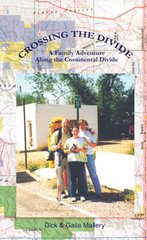
The following is a little history lesson in the politics of Rocky Mountain National Park, Elk and the Continental Divide National Scenic Trail. When I hiked the CDT in 1999 I was told not to follow the Divide because it would interrupt Elk calving. Now their shooting the beasts with guns equipped with silencers and night-vision scopes. The route the park service is suggesting is a beautiful loop through the park. Okay, that’s nice, but by the time you reach the park you have been through mega spectacular heights already, why not stay on route? The marked route in 1999 was still leaving Grand Lake, hiking about twenty minutes up the Great Kickalatapoo Trail (Tanahutu trail), the trail used by horse riding stables in Grand Lake to take short rides into the park, and exiting the park at Kawuneeche visitor center. A better option would be this:
tanahutu trail
to the Onahu Creek Trail
to Timber Lake Trail
to the Colorado River Trailhead
From there you can take a couple options back south to Bowen Lake.
HISTORY:
On November 10,1978, the President signed the "National Parks and Recreation Act" amending the "National Trails Act of 1968." The amended legislation addressed the proposed Continental Divide National Scenic Trail (CDNST). Congress directed the Forest Service to prepare and submit a comprehensive plan for the management and use of the scenic trail. This plan was completed in cooperation with other federal agencies, the public and interested private landowners in November 1985. The plan was adopted after public comment.
The entire Continental Divide National Scenic Trail corridor is approximately 3,100 miles long, extending from the Canadian border in Montana to the border of Mexico in New Mexico. About 1,900 miles of the corridor contains existing trails or primitive routes. Considerable trip planning will be necessary to determine your specific route. The corridor varies from 4,000 feet to over 13,000 feet elevation above sea level. Existing and proposed trails along the route traverse a variety of privately and publicly owned lands. The variety of situations encountered in the 3,100-mile corridor necessitate different land use and travel regulations and conditions.
The CDNST Through Rocky Mountain National Park
In 1997 the route through Rocky Mountain National Park was adjusted and now consists of approximately 30 miles of spectacular scenery. In the park, the Continental Divide National Scenic Trail route does not entirely travel the actual Divide, however the most breathtaking section is above treeline, consisting of high peaks and fragile alpine tundra. Travel is through the montane and sub-alpine life systems at elevations of 8,000 to 11,500 feet.
In north to south direction, the route enters the park on County Road 491. It then follows the River Trail north until it intersects with Trail Ridge Road (Highway 34) Near Green Mountain Trailhead. At this point the route follows the Green Mountain Trail east to the Tonahutu Creek Trail where it heads north and east to the junction of the North Inlet Trail. Here the route touches the actual continental divide at an elevation of 12,324. The North Inlet Trail is followed south and west to the town of Grand Lake. Once through Grand Lake, the route heads south along the East Shore Trail and exits the park at the south boundary. The route is entirely along existing, well-maintained trails.
Should you decide to travel the Continental Divide National Scenic Trail through the park for a few hours or several days, here are a few considerations: The air is thin at these high altitudes between 10,500 feet and 13,000 feet. Travel is slow and strenuous. Lightning danger accompanies early afternoon thunderstorms. Travel above treeline should be accomplished early in the day. Winter lasts about nine months on the Divide, from September through May. Arctic conditions prevail making travel extremely hazardous, if not impossible, during this season. Always practice Leave No Trace hiking and camping skills.
Camping Permits:
A backcountry permit is required in Rocky Mountain National Park for any overnight trips. The permits can be obtained by writing to Rocky Mountain National Park, Backcountry Office, Estes Park, Colorado 80517-8397 or call 970.586.1242.
The elk whose mating rituals draw thousands of visitors to Rocky Mountain National Park each fall are in the cross hairs — literally — because there are too many of them.
The problem is the elk have altered the park’s ecosystem by eating aspens and willows into near oblivion, wiping out habitat for beavers and birds. They also amble through the yards and gardens of homes outside the park, increasing chances for conflicts with people.
But the park’s recommended solution — using sharpshooters to cull the herd at night.
"I think everyone agrees there’s a problem," said John Baudek, mayor of Estes Park, the park’s eastern gateway.
Park officials recommended that the shooting be done at night with guns equipped with silencers and night-vision scopes to keep the culling out of public view. The program’s cost was estimated at $18 million, although Patterson said it likely will be lower in the final document. The cost includes research, monitoring and fencing to protect vegetation from overgrazing.
Other alternatives in the plan include elk birth control and releasing a limited number of wolves in the park. Biologist Johnson said the wolves’ biggest benefit would be keeping the elk on the run so they wouldn’t graze too much in one spot.
More than 100 years ago, there were no elk in the park. They were eliminated late in the 19th century by unregulated hunting.
An Estes Park civic club rallied a couple years before the park was created in 1915 to restore elk to the area by relocating them from other areas. With wolves wiped out by hunting and government extermination, elk flourished. The park controlled the size of the herd by moving some elk to other areas and culling by federal and state wildlife officers.
The herd started expanding in the late 1960s when National Park Service philosophy began relying on natural processes — predators, weather, hunting outside parks — to manage wildlife.
Environmentalists see the restoration of wolves to the area as the best answer and one that has worked in Yellowstone National Park.
Yellowstone’s elk herd grew largely unchecked in part because of the loss of most predators. That changed when wolves were released there in 1995.
"The Park Service has a mandate to restore and protect natural ecological processes," said Rob Edward of Sinapu, a Boulder-based group that advocates restoration of wolves in the southern Rockies.
Edward said his group will sue if the National Park Service decides against using wolves to manage the elk.
The Colorado Division of Wildlife has its own preference: using licensed hunters rather than federal employees or contractors to shoot the elk. State officials say hunters would do it for free and use the meat.
"What a horrible waste of the resource and a waste of the taxpayers’ money," Rick Enstrom, a former state wildlife commissioner, said of the plan to hire sharpshooters.
The idea has also gained bipartisan support in Congress. Rep. Mark Udall, D-Colo., Sen. Wayne Allard, R-Colo., and Sen. Byron Dorgan, D-N.D., have sponsored bills authorizing the two parks in their states to allow hunters to thin elk herds.
Johnson said Rocky Mountain National Park drafted its elk-reduction plan after years of study, public meetings and consulting with other states and Canadian agencies.
What seems like an obvious solution — ship excess elk to areas that want them — won’t work, Johnson said.
The herd has a low level of chronic wasting disease, a brain-wasting ailment in deer and elk that’s in the same family as mad cow disease.
State and federal laws prevent the transfer of elk for that reason. There is no economical live test for the disease. Deer and elk are tested after they’re dead.
The disease also complicates what the park can do with elk that are shot. Patterson said people have urged the park to give the meat to food banks and shelters, but federal law requires that each individual who gets the meat give consent.
"We would like to see as much of the meat used as possible," Patterson said.
cdt, Continental Divide National Scenic Trail News Blog
tanahutu trail
to the Onahu Creek Trail
to Timber Lake Trail
to the Colorado River Trailhead
From there you can take a couple options back south to Bowen Lake.
HISTORY:
On November 10,1978, the President signed the "National Parks and Recreation Act" amending the "National Trails Act of 1968." The amended legislation addressed the proposed Continental Divide National Scenic Trail (CDNST). Congress directed the Forest Service to prepare and submit a comprehensive plan for the management and use of the scenic trail. This plan was completed in cooperation with other federal agencies, the public and interested private landowners in November 1985. The plan was adopted after public comment.
The entire Continental Divide National Scenic Trail corridor is approximately 3,100 miles long, extending from the Canadian border in Montana to the border of Mexico in New Mexico. About 1,900 miles of the corridor contains existing trails or primitive routes. Considerable trip planning will be necessary to determine your specific route. The corridor varies from 4,000 feet to over 13,000 feet elevation above sea level. Existing and proposed trails along the route traverse a variety of privately and publicly owned lands. The variety of situations encountered in the 3,100-mile corridor necessitate different land use and travel regulations and conditions.
The CDNST Through Rocky Mountain National Park
In 1997 the route through Rocky Mountain National Park was adjusted and now consists of approximately 30 miles of spectacular scenery. In the park, the Continental Divide National Scenic Trail route does not entirely travel the actual Divide, however the most breathtaking section is above treeline, consisting of high peaks and fragile alpine tundra. Travel is through the montane and sub-alpine life systems at elevations of 8,000 to 11,500 feet.
In north to south direction, the route enters the park on County Road 491. It then follows the River Trail north until it intersects with Trail Ridge Road (Highway 34) Near Green Mountain Trailhead. At this point the route follows the Green Mountain Trail east to the Tonahutu Creek Trail where it heads north and east to the junction of the North Inlet Trail. Here the route touches the actual continental divide at an elevation of 12,324. The North Inlet Trail is followed south and west to the town of Grand Lake. Once through Grand Lake, the route heads south along the East Shore Trail and exits the park at the south boundary. The route is entirely along existing, well-maintained trails.
Should you decide to travel the Continental Divide National Scenic Trail through the park for a few hours or several days, here are a few considerations: The air is thin at these high altitudes between 10,500 feet and 13,000 feet. Travel is slow and strenuous. Lightning danger accompanies early afternoon thunderstorms. Travel above treeline should be accomplished early in the day. Winter lasts about nine months on the Divide, from September through May. Arctic conditions prevail making travel extremely hazardous, if not impossible, during this season. Always practice Leave No Trace hiking and camping skills.
Camping Permits:
A backcountry permit is required in Rocky Mountain National Park for any overnight trips. The permits can be obtained by writing to Rocky Mountain National Park, Backcountry Office, Estes Park, Colorado 80517-8397 or call 970.586.1242.
The elk whose mating rituals draw thousands of visitors to Rocky Mountain National Park each fall are in the cross hairs — literally — because there are too many of them.
The problem is the elk have altered the park’s ecosystem by eating aspens and willows into near oblivion, wiping out habitat for beavers and birds. They also amble through the yards and gardens of homes outside the park, increasing chances for conflicts with people.
But the park’s recommended solution — using sharpshooters to cull the herd at night.
"I think everyone agrees there’s a problem," said John Baudek, mayor of Estes Park, the park’s eastern gateway.
Park officials recommended that the shooting be done at night with guns equipped with silencers and night-vision scopes to keep the culling out of public view. The program’s cost was estimated at $18 million, although Patterson said it likely will be lower in the final document. The cost includes research, monitoring and fencing to protect vegetation from overgrazing.
Other alternatives in the plan include elk birth control and releasing a limited number of wolves in the park. Biologist Johnson said the wolves’ biggest benefit would be keeping the elk on the run so they wouldn’t graze too much in one spot.
More than 100 years ago, there were no elk in the park. They were eliminated late in the 19th century by unregulated hunting.
An Estes Park civic club rallied a couple years before the park was created in 1915 to restore elk to the area by relocating them from other areas. With wolves wiped out by hunting and government extermination, elk flourished. The park controlled the size of the herd by moving some elk to other areas and culling by federal and state wildlife officers.
The herd started expanding in the late 1960s when National Park Service philosophy began relying on natural processes — predators, weather, hunting outside parks — to manage wildlife.
Environmentalists see the restoration of wolves to the area as the best answer and one that has worked in Yellowstone National Park.
Yellowstone’s elk herd grew largely unchecked in part because of the loss of most predators. That changed when wolves were released there in 1995.
"The Park Service has a mandate to restore and protect natural ecological processes," said Rob Edward of Sinapu, a Boulder-based group that advocates restoration of wolves in the southern Rockies.
Edward said his group will sue if the National Park Service decides against using wolves to manage the elk.
The Colorado Division of Wildlife has its own preference: using licensed hunters rather than federal employees or contractors to shoot the elk. State officials say hunters would do it for free and use the meat.
"What a horrible waste of the resource and a waste of the taxpayers’ money," Rick Enstrom, a former state wildlife commissioner, said of the plan to hire sharpshooters.
The idea has also gained bipartisan support in Congress. Rep. Mark Udall, D-Colo., Sen. Wayne Allard, R-Colo., and Sen. Byron Dorgan, D-N.D., have sponsored bills authorizing the two parks in their states to allow hunters to thin elk herds.
Johnson said Rocky Mountain National Park drafted its elk-reduction plan after years of study, public meetings and consulting with other states and Canadian agencies.
What seems like an obvious solution — ship excess elk to areas that want them — won’t work, Johnson said.
The herd has a low level of chronic wasting disease, a brain-wasting ailment in deer and elk that’s in the same family as mad cow disease.
State and federal laws prevent the transfer of elk for that reason. There is no economical live test for the disease. Deer and elk are tested after they’re dead.
The disease also complicates what the park can do with elk that are shot. Patterson said people have urged the park to give the meat to food banks and shelters, but federal law requires that each individual who gets the meat give consent.
"We would like to see as much of the meat used as possible," Patterson said.
cdt, Continental Divide National Scenic Trail News Blog












No comments:
Post a Comment